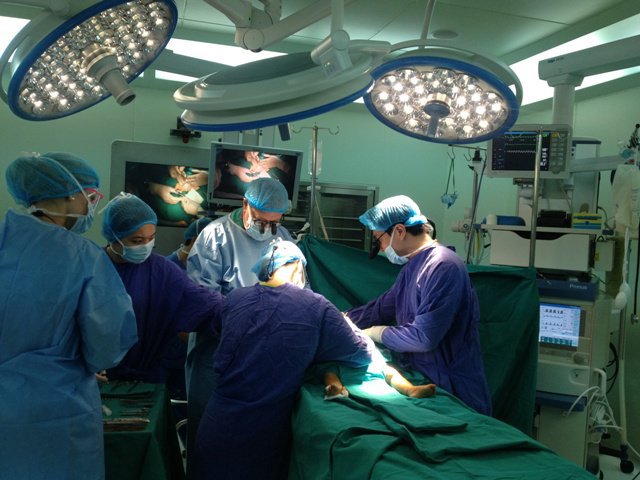Peripheral nerve splicing surgery
Injuries that cause nerve breakage, especially peripheral nerves, are difficult to treat. Because the nerve is a high-level organization, no tissue can be replaced, and there is little nourishment from the blood, so it is difficult to heal. But with the surgical technique of peripheral nerve splicing and grafting, the patient has more chances of nerve recovery.
1. Difficulty in performing peripheral neurosurgery
Peripheral nerve surgery to help restore damaged nerves. However, in the past, due to the limited support set, the implementation faced many difficulties and challenges. The reasons are:
The different functioning of nerves and other tissues makes it impossible for any tissue to replace nerves. While nerves operate on the principle of electrical impulses and conduction, other tissues almost do not operate on this principle. Therefore, when it comes to nerve injuries, it is very difficult to treat and recover.
Moreover, with other tissues, most of the blood is nourished, so when performing sutures, the wound will heal more easily. But the nerve on the contrary, is less nourished from the blood vessels, so when performing surgery, the ability to heal and restore the wound is very difficult. Moreover, the ability to recover after surgery is also not very effective. After surgery, the patient will constantly appear sensations: numbness, ants crawling, not feeling space, ... even pain like neurotumor impact.
Therefore, the difficulties in neurosurgery surgery have caused a lot of headaches for patients and doctors. For the nerve segments to be connected with a distance of 2 ends > 5mm, it can be done, but when <5mm, only hope for autologous nerve grafts.
2. Peripheral nerve grafting surgery

Phẫu thuật nối - ghép dây thần kinh ngoại biên
However, with the advancement of medicine, experts have created technical devices to support the method of nerve splicing, especially peripheral nerves. The device is called "Neural Conduit". The device has minimized complications after graft-joint surgery and increased recovery. Although it is an artificial neural tube, it has a high biological effect. Bioengineers from the University of Sheffield (Yorkshire province, UK) have collaborated with the German company Zentrum Hannover Laser to apply "biomimetic" technology to create a "neural tube" that works. Stimulates nerve regeneration and regeneration.
Nerve ducts work to help tiny nerve fibers go in the right direction and function by assembling. It has tiny microtubules and pathways for nerve fibers to grow. In addition, it contains neurodevelopmental stimulants based on a biodegradable biofilm. This speeds up the healing process, more normalizes connectivity and, more importantly, does not form neuromas.
If before defects <5mm, autologous nerve grafts should be relied on, but now <5mm defects can be indicated for neurotransplantation.
With the neural tube, the nerve-splicing surgery has brought hope to patients with nerve damage. However, this method will not be indicated for patients with diseases such as syphilis, tuberculosis, or old age and weak health who do not meet the requirements for surgery.
For infected wounds, nerves are crushed so much that covering the suture area cannot be done, surgery is not indicated. Especially for nerves with severe atrophy and degeneration are also not indicated.
3. Carrying out surgery - peripheral nerve grafting

Gây mê nội khí quản trước khi tiến hành phẫu thuật nối - ghép dây thần kinh ngoại biên
Step 1: Prepare
To perform surgery - peripheral nerve transplantation, the hospital needs to prepare a surgical team including: 3 doctors (1 main surgeon and 2 supporting doctors); 2 nurses; 1 anesthesiologist and 1 anesthesiologist. Full range of surgical instruments, including: Microsurgery glasses; Consumables and Sealed Drains placed under the skin. On the patient side, the whole body is cleaned. Before surgery, there will be clinical examination: local examination, physical examination, sensation and tests: chest X-ray, hand X-ray, blood count, blood clot, biochemistry, immunology, urine... Step 2: Procedure
The patient is disinfected in the area where the surgery is performed, steamed or covered with an elastic bandage. The lying position should expose the limb with nerve damage. Regional anesthesia or brachial plexus anesthesia or endotracheal anesthesia depends on the patient's condition and the associated lesions. Based on the wound or scar line, the surgeon makes an opening. Remove the two dead ends of the damaged nerve cord from the surrounding tissue by dissection and exposing. Depending on the patient's condition, treatment of other injuries such as fractures, tendon ruptures, muscle and blood vessel damage. Under the microscope, sutures are performed on the outer nerve sheath, the fiber bundle. Need to prepare the saphenous nerve for grafting, if the defect is < 5mm Step 3: Close the incision, place a closed drain on the surgical site. End of surgery. The patient is immobilized with a nerve-paired limb
4. Post-surgery - peripheral nerve transplant

Sau phẫu thuật nối - ghép dây thần kinh ngoại biên bệnh nhân vẫn sủ dụng thuốc kháng sinh
After the surgery, the patient should be closely monitored for the incision, antibiotics and rehabilitation exercises. If complications occur, they should be treated immediately.
Vinmec International General Hospital is one of the hospitals that not only ensures professional quality with a team of leading medical doctors, modern equipment and technology, but also stands out for its examination and consultation services. comprehensive and professional medical consultation and treatment; civilized, polite, safe and sterile medical examination and treatment space.
Customers can directly go to Vinmec Health system nationwide to visit or contact the hotline here for support.






